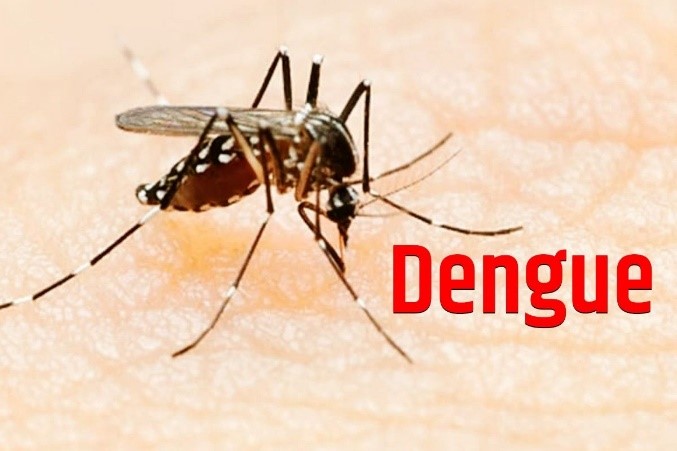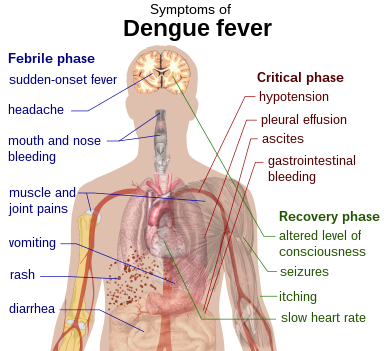Description

Disclaimer: Copyright infringement not intended
Context
- The Dengue virus in India has evolved dramatically, researchers at the Indian Institute of Science (IISC) in Bengaluru have revealed
Dengue
About
- Dengue fever is a mosquito-borne illness that occurs in tropical and subtropical areas of the world.
Dengue Virus
- Dengue fever virus (DENV) is an RNA virus of the family Flaviviridae; genus Flavivirus.
- It has four serotypes: DEN-1, DEN-2, DEN-3, and DEN-4.
A serotype or serovar is a distinct variation within a species of bacteria or virus or among the immune cells of different individuals. These microorganisms, viruses, or cells are classified together based on their surface antigens, allowing the epidemiologic classification of organisms to the subspecies level.
Serotyping often plays an essential role in determining species and subspecies.

Transmission
- The virus is transmitted to humans by mosquitoes, that become infected by biting an infected person.
- Dengue is spread by several species of female mosquitoes of the Aedes genus, principally Aedes aegypti.
Impact on body
- Once the virus enters the human body, it replicates in white blood cells called monocytes and macrophages, which are a part of the body's immune system.
- The virus then spreads to other organs, including the liver, spleen, and lymph nodes, causing a range of symptoms.
Symptoms
- Symptoms typically begin three to fourteen days after infection.
- These may include a high fever, headache, vomiting, muscle and joint pains, and a characteristic skin itching and skin rash.

Treatment
- Treatment of acute dengue is supportive and includes giving fluid either by mouth or intravenously for mild or moderate disease. For more severe cases, a blood transfusion may be required.
Prevention
- Methods of prevention include reducing mosquito habitat and limiting exposure to bites.
- This may be done by getting rid of or covering standing water and wearing clothing that covers much of the body.
Types of Vaccines
- Two types of dengue vaccines have been approved and are commercially available.
- On 5 December 2022 the European Medicines Agency approved Qdenga, a live tetravalent attenuated vaccine for adults, adolescents and kids from four years of age.
- The 2016 vaccine Dengvaxia is only recommended in individuals who have been previously infected, or in populations with a high rate of prior infection by age nine.
Burden of Dengue
World
- According to WHO, 390 million dengue virus infections per year of which 96 million manifest clinically.
- 9 billion people are at risk of infection with dengue viruses.
- In recent decades, the global incidence of dengue has increased alarmingly, and about half the world’s population are at risk Globally, there is an eight-fold increase in dengue cases from 505,430 in 2000 to 5.2 million cases in 2019 .
- Even though dengue risk is reported in 128 countries, the actual burden (70%) is in Asia, and India is one of the major contributors.
India
- Based on the International Journal of Infectious Diseases data, an estimated 33 million clinically apparent dengue cases occur in India each year, contributing to a third of the total global dengue burden (Bhatt et al., 2013).
- Increasing numbers of dengue cases and fatalities are being reported in multiple urban and rural settings in India.
- Since 2010, a dengue incidence of greater than 15 per million population has been reported annually.
- According to National Vector Borne Disease Control Program (NVBDCP), in 2022 India reported more than 110,473 dengue cases with 86 deaths.
- Dengue is highly prevalent in the northern states of India, and the highest prevalence is observed in Delhi (5.6%), followed by Dadra & Nagar Haveli (3.3%) and Chandigarh (3.1%). Delhi (14.3%) and Haryana (7.3%) show the highest prevalence of CHIKV cases. Dengue/CHIKV is not reported in most north-eastern states.
- In 2020, India's case fatality ratio for dengue was 0.06. In other words, six percent of the total cases reported were highly severe, frequently leading to death. The fatality rate decreased in the last few years.
- Dengue transmission is closely associated with three key factors — rainfall, humidity and temperature— which dictate the geographies in which dengue spreads and the transmission rate. In India, the number of months suitable for dengue transmission by Aedes aegypti mosquitoes has risen to 5.6 months each year.

How has Dengue evolved in India?
- IISC researchers examined 408 genetic sequences of Indian dengue strains from infected patients collected between the years 1956 and 2018. They found that the sequences are changing in a very complex fashion.
- It was noted that until 2012, the dominant strains in India were Dengue 1 and 3.
- But in recent years, Dengue 2 has become more dominant across the country, while Dengue 4 – once considered the least infectious – is now making a niche for itself in South India.
- Concern: Even as dengue remains a major health concern in India, there is no vaccine available for the disease. The Indian Council of Medical Research is in the midst of phase-3 trials of a vaccine candidate that has been jointly developed by Serum Institute and Panacea Biotec.
What can be done at Policy Level?
- Rather than restricting to curative and diagnostic services, a systematic and concerted strategy is required that would incorporate all four broad components of the health system – services provision, resource creation, financing, and stewardship/governance. A partial approach is not likely to succeed.
Service provision:
- Health facilities need to be kept ready for surge capacity at the out-patient and in-patient levels so that patients can visit and consult doctors in a timely manner.
- There should be more focus on population services including awareness generation prior to the disease season, mosquito control etc.
Creating resources:
- Availability of sufficient public health staff should be ensured to visit communities to check mosquito breeding sites, conduct fogging and take other preventive measures.
- Adequate supplies of insecticides, spray machines etc. should be provided.
- On curative side, clinics and other health facilities should be equipped with trained manpower and regents for conducting tests for dengue virus, and human resources for counselling patients etc.
Financing:
- As described above, often either sufficient financing is not available to conduct community outreach efforts for prevention, and whatever is available is not released on time.
- Sufficient funds need to be allocated for prioritizing public health activities, including recruitment and training of the staff.
Stewardship and governance:
- As for all diseases, the mechanisms for reporting of dengue cases are poor.
- There is a need for strengthening disease reporting systems and to use the information on cases/ deaths as a basis for action.
- Policies should be informed by learning from local experiences, and accountability mechanisms should be put in place to ensure that planned public health actions are implemented in a timely manner.
- Big metropolitan cities such as Delhi have a multitude of agencies delivering public health services. There needs to be strong leadership to coordinate the efforts of various agencies.
Prevention better than cure
- Detailed mosquito control plans should be developed prior to the dengue season.
- There is a need for public awareness generation to prevent mosquito breeding.
- Local bodies should undertake regular assessments and checks, including punitive measures such as fines for violation of suggested processes.
- The different government departments should coordinate to ensure sanitation and avoid mosquito breeding.
- The existing health facilities including district hospitals and medical colleges need to be involved in the process.
- Community engagement should be ensured through councillors in municipal corporations, MLAs (Member of Legislative Assembly) and MPs (Member of Parliament).

Closing Remarks
- In summary, mosquitoes are an integral part of our ecosystem. All attempts to make them disappear have failed.
- Hence, dengue is not likely to go away entirely. However, the burden of dengue can be reduced significantly through coordinated efforts by public health authorities, with focus on all components of the health system.
|
PRELIMS PRACTICE QUESTION
Q. Which of the following statements are correct?
a) Dengue fever virus (DENV) is an DNA virus of the family Flaviviridae; genus Flavivirus and it has four serotypes: DEN-1, DEN-2, DEN-3, and DEN-4.
b) Dengue is spread by several species of female mosquitoes of the Aedes genus, principally Aedes aegypti.
c) Dengue Virus replicates in white blood cells called monocytes and macrophages, which are a part of the body's immune system.
d) The vaccine Dengvaxia is only recommended in individuals who have been previously infected with Dengue Virus, or in populations with a high rate of prior infection by age nine.
1. a and b only
2. a, b and c only
3. b, c and d only
4. a and c only
Answer: 3
|
https://www.indiatoday.in/science/story/dengue-virus-in-india-has-evolved-scientists-highlight-urgent-need-of-vaccine-2366983-2023-05-01












